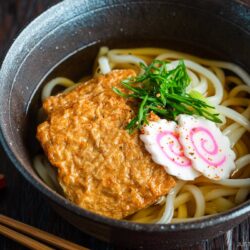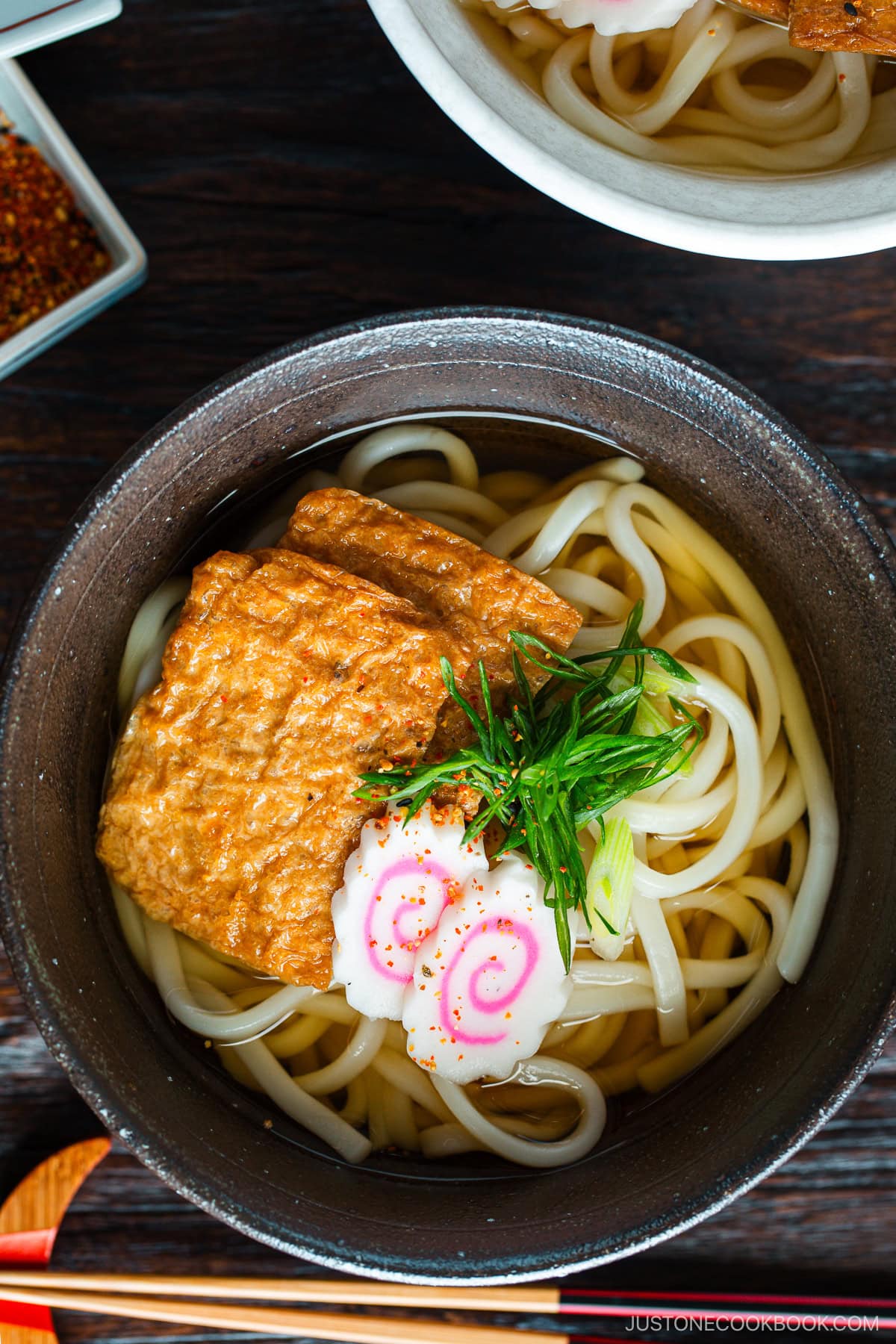
If you’re looking for the ultimate Japanese comfort food that can lift up your mood any time of year, I can’t recommend enough cooking this bowl of Kitsune Udon (Noodle Soup) (きつねうどん). It’s a humble dish, yet so comforting and satisfying.
The rich broth, chewy noodles, and fried tofu pouches—everything comes together so nicely that you just want to hold your face above the bowl and let the aroma envelop you. It’s so simple and quick to make this kitsune udon recipe, so there is no excuse not to try it!
What is Kitsune Udon?
Kitsune udon is a traditional Japanese noodle soup of chewy and thick udon noodles, light and flavorful dashi broth, and deep-fried tofu pouches (aburaage) seasoned with soy sauce, mirin, and sugar. We typically served it hot, but in the sweltering summer months, we enjoy it chilled with a few spoonfuls of dashi-based sauce poured on top.
Kitsune means “fox” in Japanese. There are a few theories about why we call this dish “fox udon.” One is that aburaage appears as a fox’s favorite food in Japanese folktales, so people call this dish kitsune udon from the tofu pouches on top. Another theory is that aburaage is called kitsune because it’s the same color as a fox. This makes the most sense to me since Japanese recipes often say to “cook to a fox color” to describe a golden brown color.
3 Key Ingredients for Kitsune Udon
To make the perfect bowl of kitsune udon, you need high-quality ingredients, starting with dashi (Japanese soup stock), udon noodles, and aburaage.
1. Dashi Stock
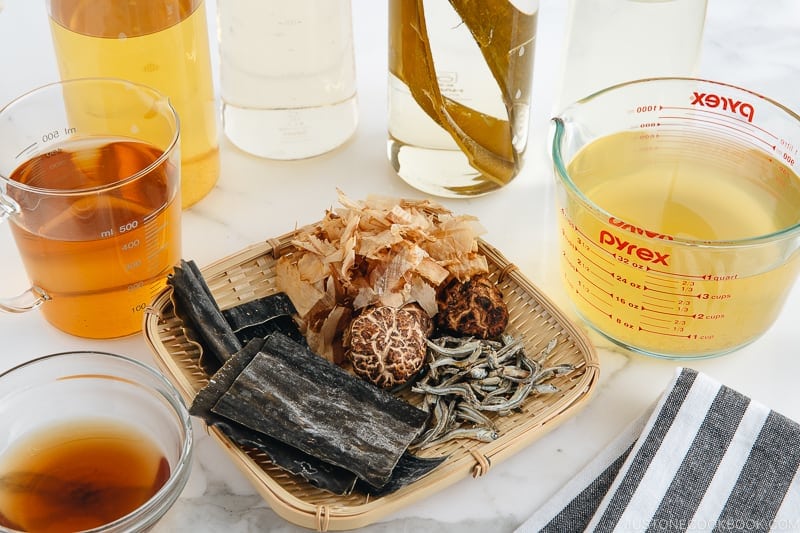
I can’t stress enough the importance of good-quality dashi. It gives the soup that rich, umami flavor that you’ll want to sip to the last drop. In the past, I’ve shared three ways to make dashi with dashi powder, a dashi packet, or from scratch. For this recipe, I only recommend using homemade dashi or a dashi packet. Dashi powder doesn’t provide enough depth for a flavorful broth.
Please don’t be intimidated by making dashi from scratch. Spend the extra 20 minutes to make a super tasty broth—trust me, it’s worth your time and it’s easy to make! I recommend Awase Dashi (kombu + katsuobushi/bonito flakes) or Katsuo Dashi (just bonito flakes) for udon noodle soup broth. For vegetarian/vegan dashi, use Kombu Dashi.
2. Udon Noodles
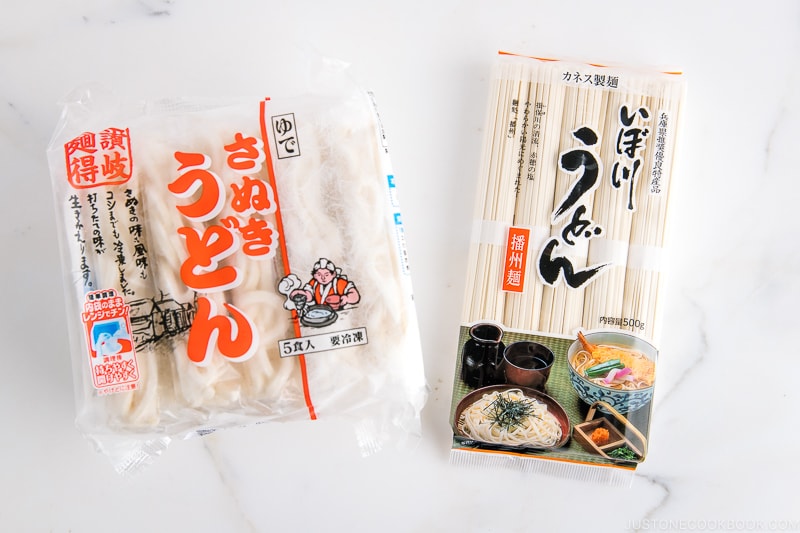
Udon noodles are now popular outside of Japan, so you can easily purchase them in regular US grocery stores. However, many products are not very good. The noodles don’t have the right texture and tend to break into pieces.
If your local Japanese or Asian grocery stores carry frozen Sanuki udon noodles in the freezer section or parboiled Sanuki udon noodles, try one of those options. They are chewier and not doughy/floury, and won’t break as easily.
3. Aburaage: Packaged vs. Homemade

Living outside of Japan, I know that raw ingredients can be harder to find than prepackaged foods. Inari age (seasoned deep-fried tofu pouch) is made of aburaage (deep-fried tofu pouch). When you want to make homemade Inari age, you need aburaage, but it’s really difficult to find unless you have a well-stocked Japanese grocery store.
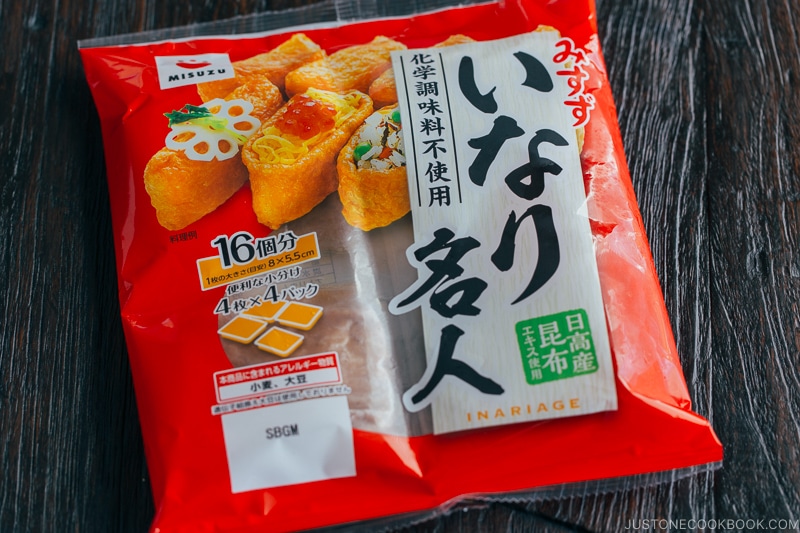
Packaged Inari age is widely available even in Asian grocery stores as they are used for making the popular Inari Sushi. If you are lucky enough to find aburaage, try making my Homemade Inari Age! It’s preservative-free and really delicious!
Ingredients for Kitsune Udon
Here’s a complete list of ingredients you’ll need:
- kombu (dried kelp), water, and katsuobushi (dried bonito flakes) – for the dashi
- dashi, mirin, sugar, salt, and usukuchi (light-colored) soy sauce – for the soup broth; you can substitute regular soy sauce
- Inari age (seasoned fried tofu pouch) – canned or refrigerated; or make it homemade
- green onion/scallion
- narutomaki (fish cakes) – optional
- udon noodles
- shichimi togarashi (Japanese seven spice) – optional; sprinkle for a spicy kick
How to Make Kitsune Udon
Here’s a quick overview; see my recipe below for full instructions.
- Make the homemade dashi. Heat kombu and cold water in a saucepan. Before it boils, remove the kombu. Add the katsuobushi, simmer briefly, and turn off the heat. Let the bonito flakes sink, then strain the stock.
- Cook the udon broth. Add the broth ingredients to a saucepan and bring to a boil over medium heat. Then, cover and keep on a low simmer.
- Prepare the toppings. Squeeze the liquid from the Inari age. Thinly slice the green onion and narutomaki.
- Boil the udon noodles in a large pot of water per package directions and drain well.
- Assemble the kitsune udon. Divide the noodles into individual bowls. Pour in the broth and top with Inari age, narutomaki, and sliced scallions.
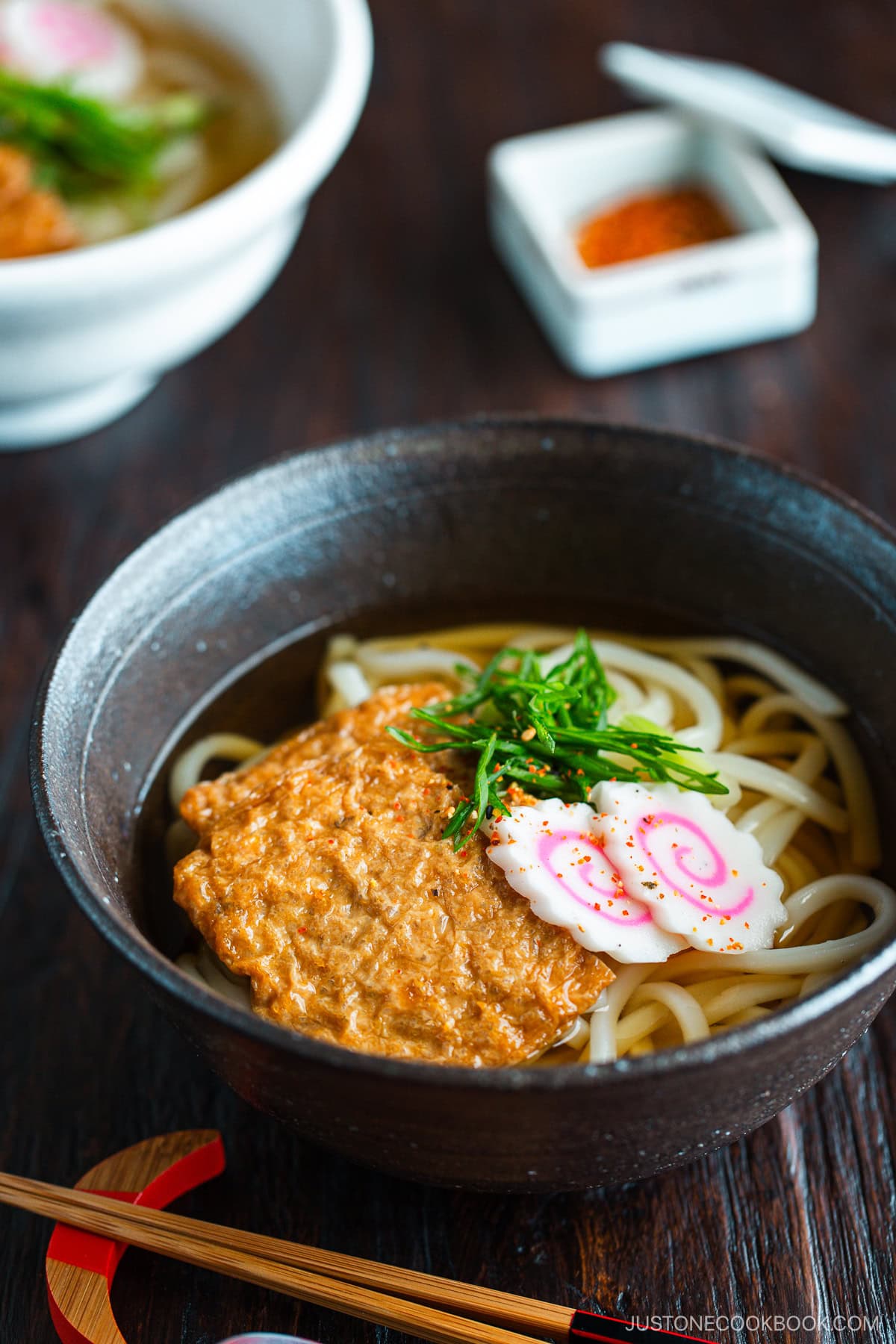
Vegetarian/Vegan-Friendly Kitsune Udon
There is a misconception that dashi is not vegetarian/vegan, but that’s not completely true. While standard dashi is made with bonito flakes and kombu, we also use which is 100% vegetarian/vegan Kombu Dashi in our daily Japanese cooking.
Use kombu dashi to make vegetarian/vegan kitsune udon and skip those spiral fish cakes as a garnish. And as simple as that, you have a vegetarian/vegan udon!
Did you watch Netflix “Midnight Diner: Tokyo Stories” Season 2?
You can find this Kitsune Udon dish featured on the popular Netflix® – Midnight Diner: Tokyo Stories (Season 2, Episode 7).

In the show, the master prepares a bowl of Kitsune Udon with a large homemade Inari age. It’s such a humble dish, yet so comforting and satisfying.
Other Hot Udon Noodle Soup Recipes
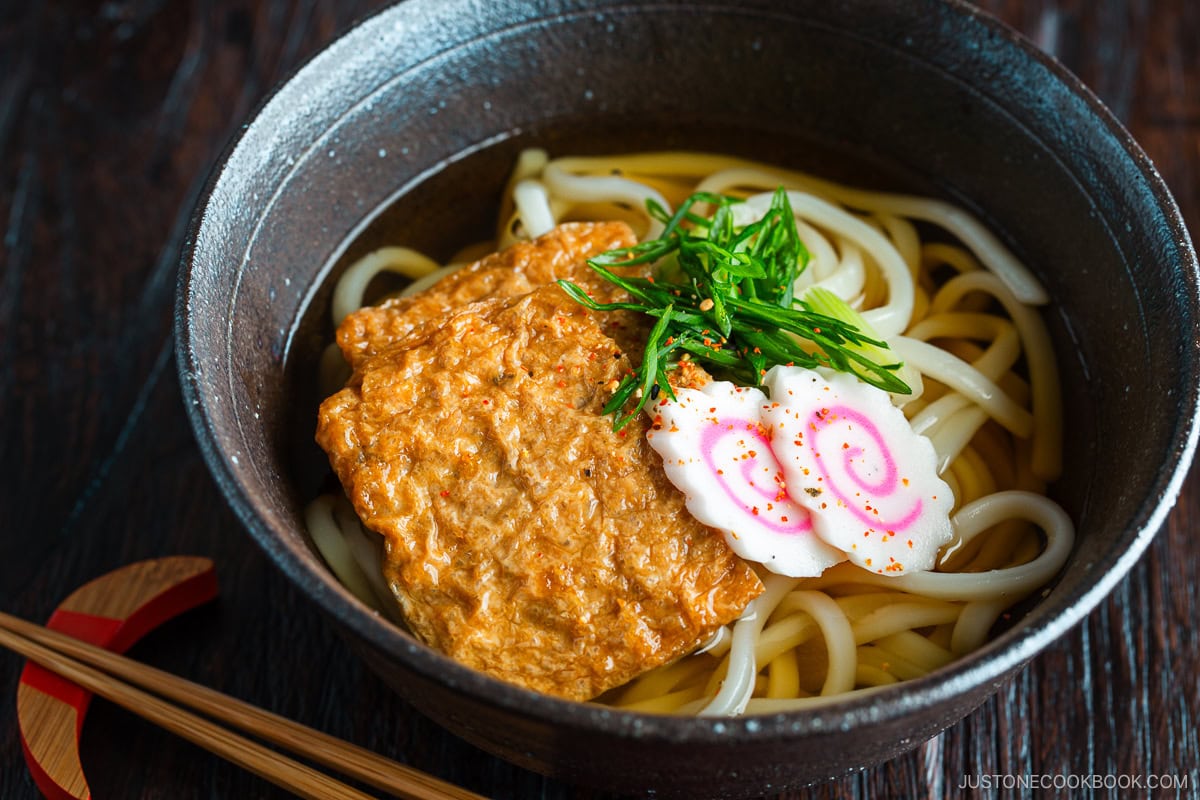
Kitsune Udon
Ingredients
For the Homemade Dashi
- 1 piece kombu (dried kelp) (2 x 5 inches, 5 x 12 cm per piece)
- 2½ cups water
- 1½ cups katsuobushi (dried bonito flakes) (packed; ½ oz; skip for vegetarian/vegan)
For the Soup Broth
- 2½ cups dashi (Japanese soup stock) (use standard Awase Dashi, dashi packet or powder, or Vegan Dashi); dashi recipe instructions included below)
- 1 Tbsp mirin
- 1 tsp sugar
- 1 Tbsp usukuchi (light-colored) soy sauce (can substitute regular soy sauce)
- ½ tsp Diamond Crystal kosher salt
For the Kitsune Udon
- 4 Inari age (seasoned fried tofu pouch) (canned or refrigerated; or make my homemade Inari Age)
- 1 green onion/scallion
- 4 slices narutomaki (fish cakes) (optional; skip for vegetarian/vegan)
- 2 servings udon noodles (1.1 lb, 500 g frozen or parboiled udon noodles; 6.3 oz, 180 g dry udon noodles)
- shichimi togarashi (Japanese seven spice) (optional; or a spicy kick)
Instructions
Before You Start…
- Gather all the ingredients. It‘s really important to have good flavorful dashi for this recipe. Although you can take a shortcut by using dashi powder or a dashi packet, I encourage you to make dashi from scratch because the broth tastes so much better! It only takes less than 30 minutes to make. See my instructions below for Awase Dashi and Kombu Dashi (vegetarian/vegan).
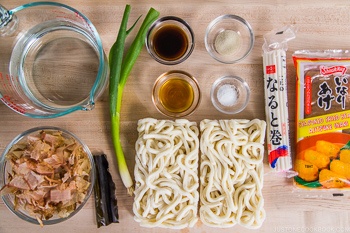
To Make the Homemade Dashi
- Put 1 piece kombu (dried kelp) and 2½ cups water in a measuring cup for at least 30 minutes. If you have time, soak for 3 hours or up to half a day. The kombu’s flavor comes out naturally from soaking it in water. If you don’t have time, skip soaking.
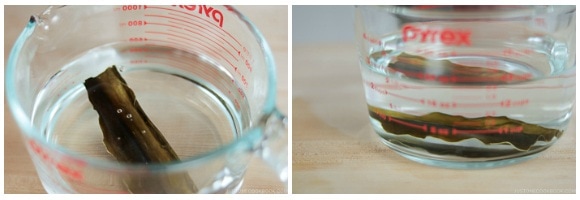
- Transfer the kombu and water to a saucepan. Slowly bring to a boil over medium-low heat.
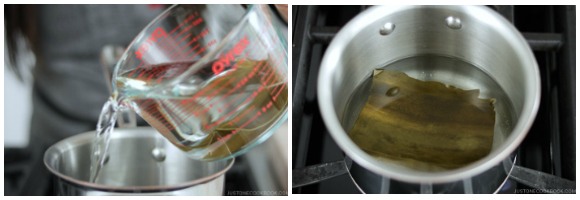
- Just before the liquid boils (you will see bubbles around the edges of the pan), remove the kombu. If you leave the kombu inside, the dashi will become slimy and bitter. Now, this broth is vegetarian/vegan Kombu Dashi and it‘s ready to use. For non-vegetarian/vegan, add 1½ cups katsuobushi (dried bonito flakes) and bring it to a boil again.
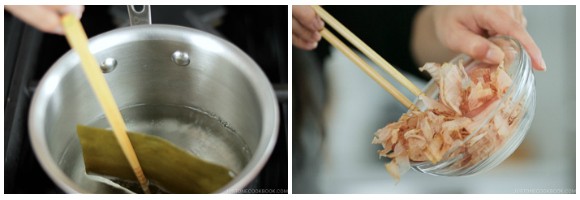
- Once the dashi is boiling, reduce the heat, simmer for just 15 seconds, and turn off the heat. Let the katsuobushi sink to the bottom, about 10–15 minutes. Strain the dashi through a fine-mesh sieve set over a saucepan. Now you have homemade Awase Dashi.
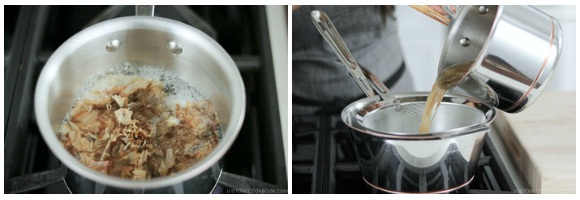
To Make the Soup Broth
- In a saucepan, add 2½ cups dashi (Japanese soup stock), 1 Tbsp mirin, 1 tsp sugar, 1 Tbsp usukuchi (light-colored) soy sauce, and ½ tsp Diamond Crystal kosher salt and bring it to a boil. Once boiling, turn off the heat or cover and keep on a low simmer. Tip: We use the light-colored usukichi type of soy sauce here so the color of the soup broth doesn‘t become too dark.
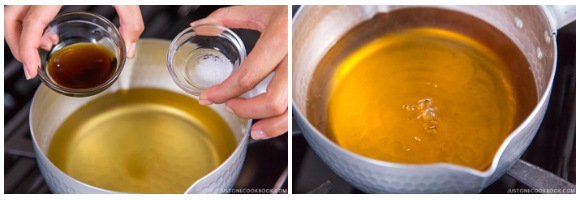
To Prepare the Toppings
- Squeeze the excess liquid from 4 Inari age (seasoned fried tofu pouch) (or you can keep the liquid as is, if you prefer). Cut 1 green onion/scallion into thin slices. Cut 4 slices narutomaki (fish cakes) into ⅛-inch (3-mm) slices.

To Cook the Udon Noodles
- Bring a large pot of water to a boil for 2 servings udon noodles. My favorite udon is frozen Sanuki udon. Reheat the frozen udon noodles in boiling water for 1 minute (no need to defrost). If you use dry noodles, follow the package instructions.
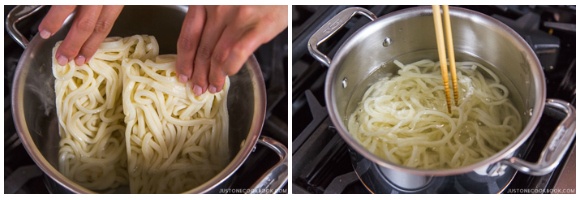
- Pick up the noodles in a strainer or drain the hot water. Make sure to shake off the excess water (which will end up diluting your soup).
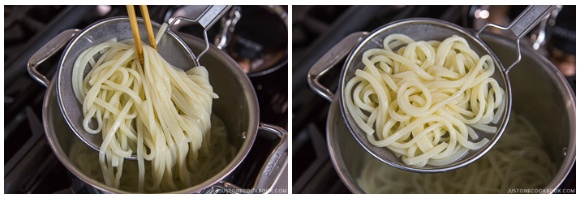
To Serve
- Divide the drained udon noodles into individual serving bowls. Pour the hot broth over the noodles to cover. Top with the Inari age, narutomaki, and green onions. Sprinkle shichimi togarashi (Japanese seven spice) on top (optional).
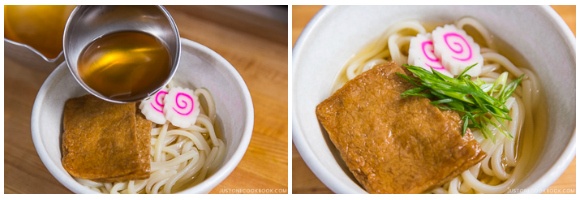
To Store
Nutrition
Did you make this recipe?
Tag @justonecookbook on Instagram so we can see your delicious creation!
Editor’s Note: The post was originally published on May 25, 2011. Pictures were updated in November 2017. The new video was added in April 2018. The post has been updated in May 2020.


